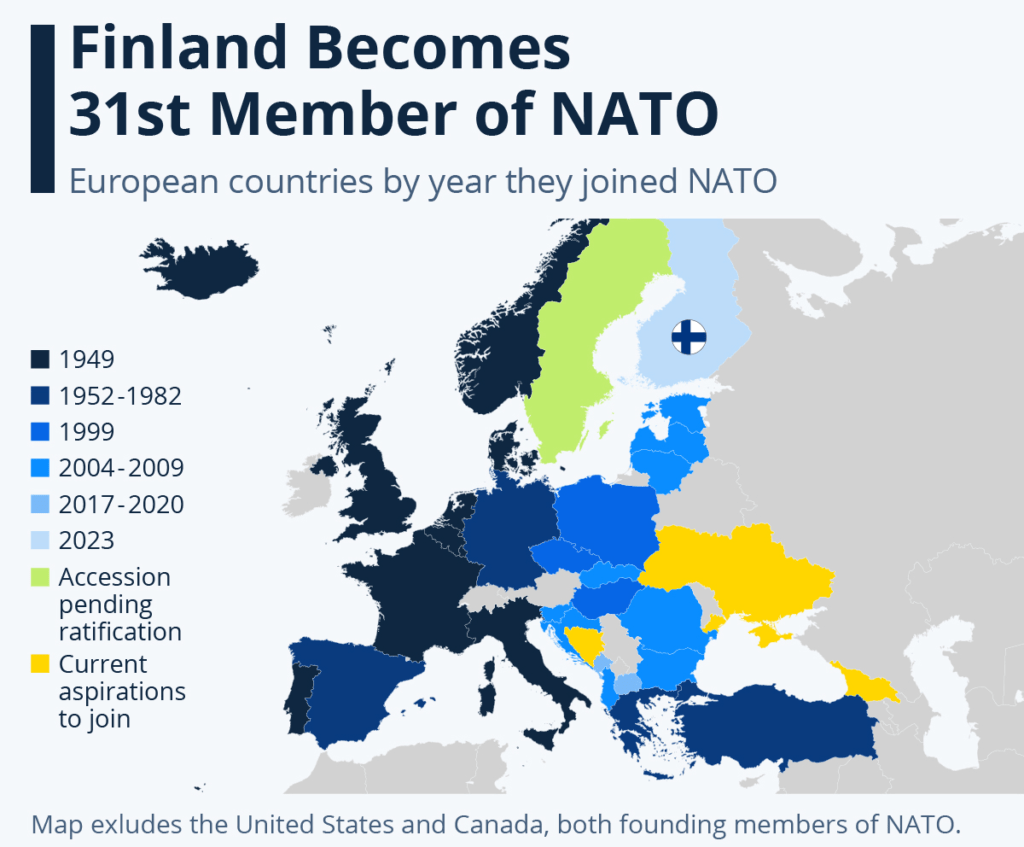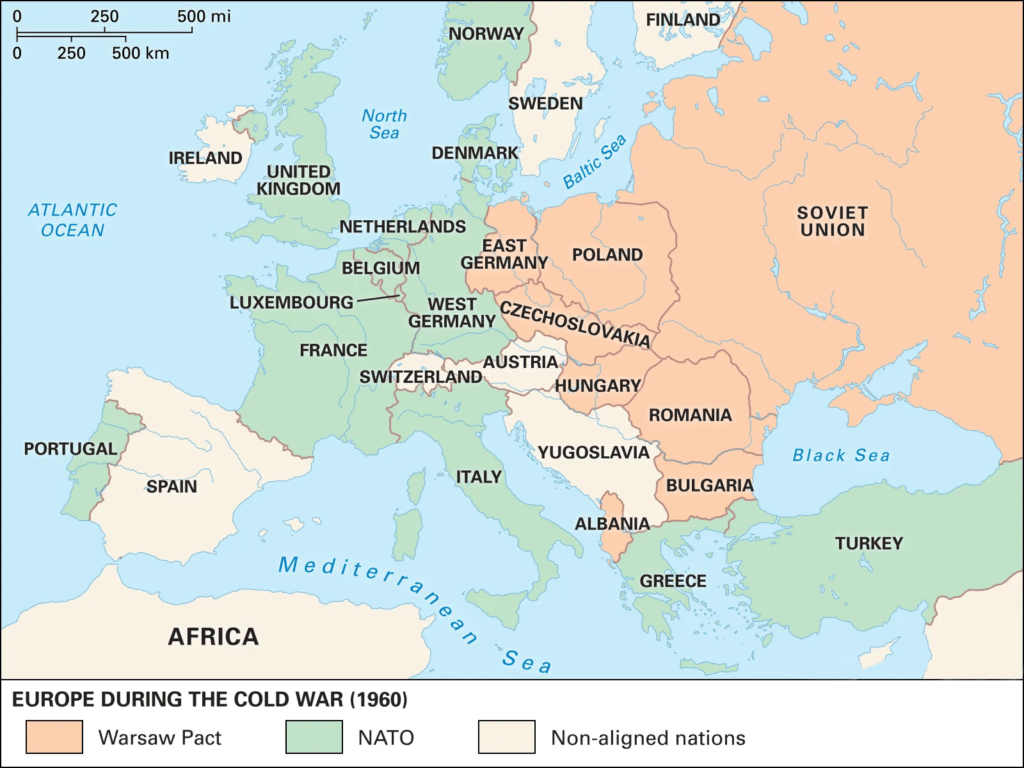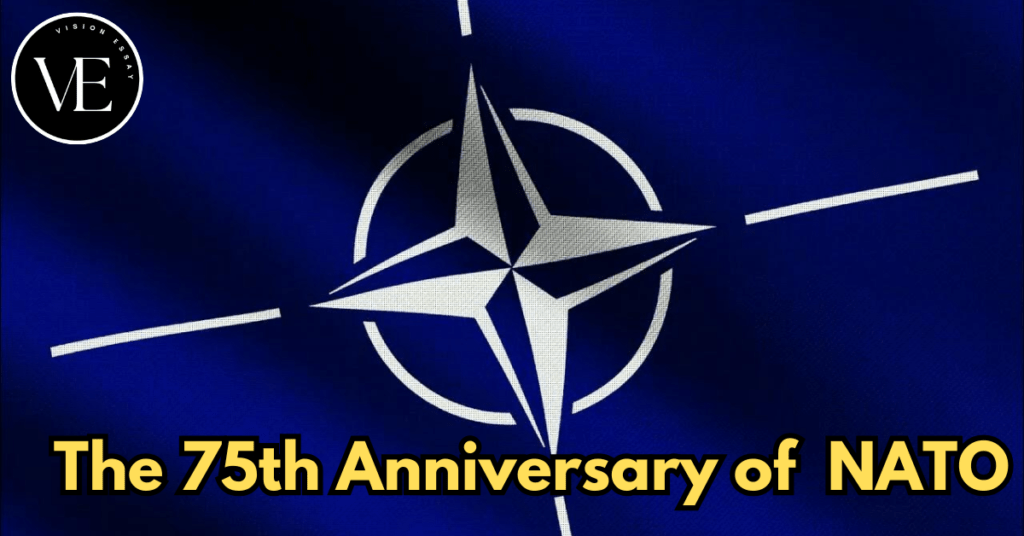The 75th Anniversary of NATO
Introduction
On April 4, 1975, the North Atlantic Treaty Organization (NATO) ostentatiously commemorated its founding anniversary. Western nations convened in Washington, DC, on this day in 1949 to pledge support for one another’s defense. As fresh dangers approached and the wounds from the Second World War were still fresh, they vowed to protect their people’s independence. Reaffirming the alliance’s commitment to democracy, freedom, and the rule of law, tackling new security threats like Russia’s invasion of Ukraine, and laying out a plan for NATO’s future adaptation are among the main topics of attention for the alliance’s 75th anniversary.
What is NATO?
A military alliance with intergovernmental participation, the North Atlantic Treaty Organization was established in 1949. During the Cold War, its main objective was to provide collective defense against any assault, especially from the Soviet Union. NATO’s basic purpose has been expanded upon throughout time to handle a variety of security problems.
What is the History of NATO?
- Formation: On April 4, 1949, twelve founding member nations from Europe and North America signed the North Atlantic Treaty in Washington, D.C., establishing NATO.
- Cold War Era: NATO acted as a check on Soviet expansionism during the Cold War, with the US giving its European allies substantial military backing.
- Post-Cold War: Following the fall of the Soviet Union, NATO broadened its purview to encompass cooperative security initiatives, crisis management, and conflict avoidance.
How many Members are in NATO?
- Original Members: Belgium, Canada, Denmark, France, Iceland, Italy, Luxembourg, the Netherlands, Norway, Portugal, the United Kingdom, and the United States were the original 12 founding members of NATO.
- Expansion: Since its establishment, NATO has grown by admitting new members in several waves. There are presently 32 nations in the alliance.
What are the Mission and Objectives of NATO?
- Collective Defence: Collective defense is the main objective of NATO, as stated in Article 5 of the North Atlantic Treaty. According to this article, if one member nation is attacked, all members will be targeted, and they will retaliate as a group.
- Crisis Management: NATO carries out crisis management operations, such as conflict avoidance, peacekeeping, and stabilization initiatives in many global locations, in addition to collective defense.
What is the Structure of NATO?
- Political Leadership: The main political decision-making body of NATO is the North Atlantic Council (NAC), which is made up of ambassadors from each of its member nations.
- Military Command Structure: The military command structure of NATO consists of Regional Commands, Force Headquarters, and Strategic Commands (such as Allied Command Operations), which are in charge of operational planning and implementation.
- Integrated Military Forces: By maintaining integrated military forces, NATO enables its member nations to provide resources and men for joint defense operations that are overseen by the organization.

What are the Various Issues Regarding the Operation of NATO?
- Unrestrained Offensive
- NATO was established to protect its members from external threats. According to the facts, it was never harmed by one or in danger of one. Quite the opposite, NATO launched an attack to defend its member nations. It has started or taken part in more than 200 military confrontations globally over the past 70 years, including 20 significant ones.
- Misadventures in Eastern European, Middle East and Asian Countries
- The most notable examples among many include the bombing of Yugoslavia, the invasion of Iraq, the collapse of Libya as a state, the illegal military intervention in Syria, and the questionable outcomes of the fight against terrorism in Afghanistan.
- Provoking Russia-Ukraine War
- The biggest provocation of all time has been the alliance’s five waves of growth since 1991, despite claims to the contrary and Ukraine’s metamorphosis into a launchpad against Russia.
- At the NATO summit in Madrid in 2022, the alliance abolished the discussion channels with Russia and approved the Strategic Concept, which declares Moscow to be the most important and direct danger to ally security, peace, and stability in the Euro-Atlantic—something Russia has never been.
- Maintaining Western Hegemony
- The harsh truth is that NATO attacks or threatens to attack every state that rejects the decrepit liberal “rules-based order,” all the while announcing its peaceful goals.
- This establishes the idea that NATO is merely carrying on colonial activities in a contemporary manner while using the Euro-Atlantic rulers’ mandated themes of democracy, human rights, and freedom.
- Unwarranted Expansion
- The coalition is strengthening its cyber and outer-space capabilities. In preparation for the modified regional military plans, NATO’s “eastern flank” is being bolstered with more soldiers and capabilities. The hostile actions of NATO go beyond Russia. We are looking for additional partners throughout Latin America, Asia, and Africa.
- NATO’s focus has shifted from historically strong connections between nations to the post-Soviet area and Eurasia as a whole to further exacerbate tensions.
- Capitalizing the Threat Posed in The Indo-Pacific
- Under the pretext of “indivisibility of security in the Euro-Atlantic and Indo-Pacific regions,” NATO is attempting to expand its responsibilities across the entire eastern hemisphere, which is a fresh example of the block’s expansionism.
- To force them into actual collaboration with NATO, the US has been busy developing pocket multilateral frameworks, such as AUKUS, the US-Japan-South Korea troika, and the Tokyo-Seoul-Canberra-Wellington quartet.
What were the successes and drawbacks of the NATO grouping?
- Successes
- The Cold War
- NATO’s actions during the Cold War were centered on three objectives: reining in the Soviet Union, deterring communism and extremist nationalism throughout Europe, and fostering stronger political unification among Europeans.
- The partnership was crucial in keeping the Cold War calm and making sure it stayed “cold.” NATO endeavored to further uphold peace after the conflict.
- They founded the North Atlantic Cooperation Council, and in 1997, the Founding Act of NATO promoted bilateral talks between the United States and Russia.
- Modern Day Protection
- NATO still offers its members some degree of security today. Only once since NATO’s founding—by the US on 9/11—has a member been attacked and Article 5 used.
- Collective security is provided to member nations, exactly as NATO was intended to. Furthermore, NATO has established an international network encompassing over 40 nations and other global partners, such as the Organization for Security and Cooperation in Europe (OSCE) and the African Union.
- NATO uses this network to assist its crisis management operations, which include counterterrorism operations in the Mediterranean and along Somalia’s coast, as well as aid missions like delivering supplies during the 2005 Kashmir earthquake.
- Providing Humanitarian Aid to Ukraine
- NATO member nations and allies have generously sent significant help to Ukraine, while the alliance has openly condemned Russia’s invasion of that country. Approximately USD 54 billion has been donated to Ukraine by the US.
- More than 5 million war refugees have received support and humanitarian aid from other nations. NATO’s significance has been underlined by the conflict in Ukraine, which has also encouraged Finland and Sweden to step up their efforts to join.
- By enhancing its air and submarine capabilities, these nations’ participation would fortify NATO’s military position and enable it to further deter Russian attacks.
- The Cold War
- Drawbacks
- Funding Issues
- The defense ministers of NATO member states pledged in 2006 to devote 2% of their GDP to defense expenditures. Nevertheless, most NATO members fall short of this objective. At the now, the US finances more than two-thirds of the alliance’s defense.
- Afghanistan
- NATO had a significant presence in Afghanistan following 9/11, and its soldiers were essential in helping the Afghan government. NATO and US forces were pulled out of Afghanistan in 2020 after President Donald Trump struck a deal with the Taliban.
- The Taliban promptly overthrew the Afghan government as a result of this. NATO spent twenty years in Afghanistan, but no lasting solution was found, and the country’s previous administration could not continue without them.
- Right-Wing Nationalism
- Discontent with international organizations like NATO and the EU increases as right-wing nationalism spreads throughout Europe. There may be more calls for nations to leave organizations like NATO if right-wing populist forces continue to gain traction throughout Europe. Currently, NATO’s job is to unite a divided Europe while countering and addressing their criticism.
- Russian Aggression
- Since the collapse of the Soviet Union, NATO has welcomed several former Warsaw Pact members, despite alleged verbal commitments to Russia that it would not expand to the east.
- Russia now feels more and more threatened since NATO countries surround it and there are plans for more enlargement. One of the main justifications for Russian activities in the Russia-Ukraine Conflict has been attributed to the risk of Ukraine joining NATO.
- Funding Issues

What Reforms Are Needed to Increase NATO’s Effectiveness and Efficiency?
- The Quality, Coherence and Timelines of Advice
- Increase the significance and capabilities of the Military Committee, Political Committee, Executive Working Group, Policy Coordination Group, and Senior Resource Board—the five primary policy committees in NATO.
- Ensure that these committees are more coordinated and that their agendas reflect the goals of the Council. This will assist in converting the Council’s recommendations into timely and useful assistance for NATO entities that are both military and civilian.
- NATO’s Non-Military Dimension
- Make sure that, in cooperation with other international organizations and local actors, the allies provide the Alliance with the political and operational civil expertise and capacity it needs to effectively carry out its mandate when the time comes to engage the Alliance; this may necessitate the establishment of a civil security committee or other comparable structure.
- Organisational Cohesion and Internal Synergy
- Orient not just the NATO headquarters but also a streamlined group of NATO organizations both inside and outside of Brussels to meet a changing set of strategic-level goals and improve visibility, openness, and unity of purpose throughout the Alliance.
- An Inclusive and United Alliance
- Institutional frameworks ought to reflect the interdependence of Alliance security, striving to preserve and strengthen allied cohesiveness and unity as well as promote a common goal.
- Every effort should be made to ensure that institutions and processes between the allies and the growing number of non-NATO countries foster and enable political consultation, integrated planning, training, exercises, and operations.
- The Alliance Must Remain Distinct
- Although NATO must proactively collaborate with other global institutions to tackle intricate crises via a Comprehensive Approach, this must not compromise its fundamental advantage of merging resilient military prowess with sophisticated tactics.
- Focus on Non-Traditional Threats
- While defending its territory is still NATO’s primary responsibility, many contend that the alliance has to change even more to counter non-conventional threats including supply chain security risks, cyberattacks, terrorism, and misinformation operations.
Conclusion
NATO is reaching a pivotal point in its illustrious history as it approaches its 75th anniversary in 2024. With a rules-based international order, NATO has effectively preserved its fundamental objective of defending the independence and security of its members. Nonetheless, the last several decades have seen a fast-changing picture of international security marked by the reappearance of great power rivalry, transnational threats, and challenging contemporary issues.
NATO has to keep evolving and reforming if it is to continue serving as an effective bulwark of peace and stability. This includes increasing defense capability investment, streamlining decision-making procedures, and expanding its focus to include emerging domains like as cyber, space, and technical supremacy.
Frequently Asked Questions(FAQs)
What is NATO’s primary objective?
NATO’s primary objective is to safeguard the freedom and security of its member states through collective defense and cooperation.
How many member countries are part of NATO?
Currently, NATO comprises 30 member countries from North America and Europe.
What role does NATO play in addressing global security challenges?
NATO plays a crucial role in addressing global security challenges by promoting stability, democracy, and cooperation among its member states.
What are NATO’s key priorities for the future?
NATO’s key priorities for the future include enhancing readiness, strengthening partnerships, and adapting to emerging security threats to ensure the alliance’s continued relevance and effectiveness.
Sources:
- https://www.whitehouse.gov/briefing-room/statements-releases/2024/04/04/statement-from-president-joe-biden-on-natos-75th-anniversary/
- https://www.defense.gov/News/Releases/Release/Article/3730558/statement-from-secretary-of-defense-lloyd-j-austin-iii-on-natos-75th-anniversary/
- https://ddnews.gov.in/nato-marks-75th-anniversary-with-flags-cake-message-to-us-on-ukraine/
- https://www.globaltimes.cn/page/202404/1310041.shtml
- https://www.weforum.org/agenda/2024/04/75-years-nato-explainer/

Leave a Reply